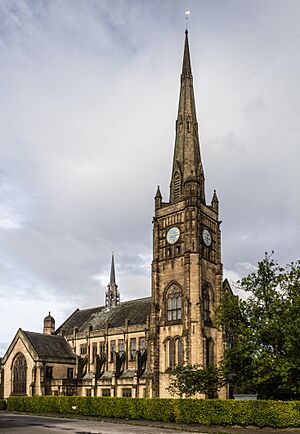Albion Congregational Church facts for kids
Quick facts for kids Albion Congregational Church |
|
|---|---|

Albion Congregational Church
|
|
| 53°29′15″N 2°05′13″W / 53.48750°N 2.08694°W | |
| OS grid reference | SJ 94326 99003 |
| Location | Ashton-Under-Lyne, Greater Manchester |
| Country | England |
| Denomination | Congregational |
| Architecture | |
| Architect(s) | John Brooke |
| Groundbreaking | 1890 |
| Completed | 1895 |
The Albion Congregational Church is a historic building located on Stamford Street East in Ashton-Under-Lyne, Greater Manchester, England. It was designed by an architect named John Brooke. Construction of the church began in 1890 and was finished in 1895. This church is considered a special building because it is a Grade II listed building. This means it is protected by law due to its important history and architecture.
About Congregational Churches
Congregational churches are a type of Christian church. They are known for each local church being independent. This means they make their own decisions about how they are run. They do not have a central authority telling them what to do. This idea of independence is a key part of their beliefs.
The Church Building
The Albion Congregational Church is a beautiful example of architecture from the late 1800s. It was built to be a place of worship for the local community. The design by John Brooke shows the style popular during that time. Buildings like this often have unique features and details.
The Church Organ
Inside the Albion Congregational Church, there is a large musical instrument called an organ. This organ was first put into the church around 1904 or 1905. It was built by a skilled organ maker named Charles Lloyd. Organs are complex instruments that use pipes to make sound.
Organ Updates
Over the years, the organ needed some care and updates. In 1953, a company called Rushworth and Dreaper rebuilt the organ. This means they took it apart, fixed any worn-out parts, and put it back together. They might have also added new features to improve its sound. You can find more details about this specific organ on special websites that list information about pipe organs, like the National Pipe Organ Register.

